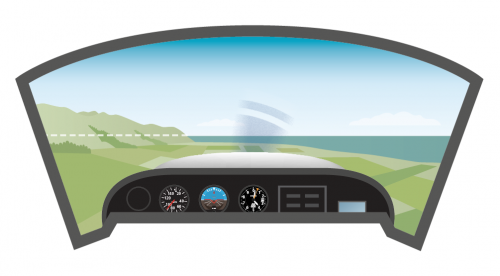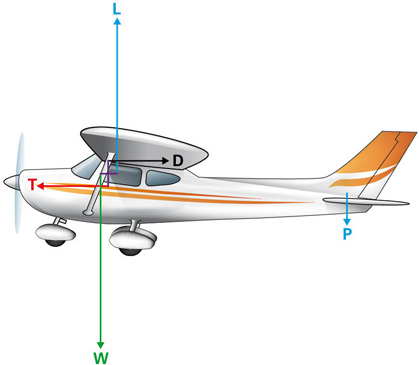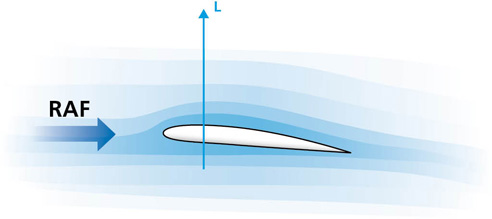Basic concepts
This lesson should start with you asking the student what they did in the last lesson, what do they remember, and determining if they have remembered correctly.
We must be able to fly the aeroplane in a straight line, on a constant heading and at a constant altitude. Maintaining a constant altitude requires a constant attitude and a constant heading requires the aeroplane to be wings level and in balance.
This is the first exercise in coordination for the student, and it's very important that they understand, and can then demonstrate, how the controls they learnt about in the previous Effect of controls lesson are used to achieve and maintain a constant heading, constant altitude, constant airspeed, and aeroplane in balance.
It's also an important lesson because it shows the interrelation of a number of variables, such as power, airspeed, pitch and yaw.
The lesson should initially cover configuring straight and level flight at a constant airspeed, and then maintaining it. It's followed by regaining straight and level after a disturbance, and finally straight and level at different airspeeds and power settings.
It's critical that the student understands that straight and level is achieved by referencing the aeroplane's nose attitude directly in front of the pilot with the horizon (where the sky meets the sea, or an imagined line superimposed over terrain or weather), and then checked by reference to the aeroplane's instruments (see Figure 1). Use a moveable 'windscreen view' to show the correct attitude for straight and level flight.

Figure 1 The horizon is where the sky meets the sea - this needs to be imagined and superimposed over terrain or weather where the sea isn't visible.
To establish and maintain straight and level flight, at a constant airspeed, constant altitude, in a constant direction, and in balance.
To regain straight and level flight.
To maintain straight and level flight at selected airspeeds or power settings.
In VFR flight, flying straight and level should only be accomplished with reference to the horizon. Define the horizon for the student and explain how the horizon can be identified if it's not visible, for example with hills or weather in the way.
The four forces acting on the aeroplane should be explained.
Weight
Weight acts straight down through the centre of gravity.
Lift
Lift is produced by the wings and acts upwards through the centre of pressure.
Thrust
Thrust is provided by the engine through the propeller.
Drag
Drag is the force that resists movement of an aircraft through the air.
Equilibrium requires a constant airspeed and constant direction (the combination of these is velocity). A constant direction is maintained by the wings being level and the aeroplane in balance. Equilibrium is achieved when lift = weight and thrust = drag.
Describe how the arrangement of these forces forms couples. Lift acts through its centre of pressure and is slightly behind the centre of gravity, where weight acts (small moment arm), creating a nose-down pitching couple. The comparative size of the lift and weight forces to thrust and drag forces should be discussed. For general aviation aeroplanes, the lift/drag ratio is said to be about 10:1. Your diagram should reflect this ratio approximately – a picture is worth a thousand words (see Figure 2).

Figure 2 The four forces acting on an aeroplane
The ideal arrangement in training aircraft is for the thrust line to be well below the drag line. This provides a large moment arm to compensate for the smaller forces of thrust and drag, and creates a nose-up couple that balances the nose-down couple of lift and weight.
In the previous lesson Effect of controls, the student saw the pitch change when power was increased and decreased. The arrangement of these couples is the reason for the pitch changes. A decrease in power will pitch the nose down into a descent, without pilot input, and an increase in power will pitch the nose up.
In practice, getting the thrust and drag lines separated far enough to balance the lift/weight couple is not possible. Therefore, the tailplane is set at an angle of attack that will provide a down force on the tailplane in level flight, which combined with the large moment arm, balances the forces.
Any further imbalance between the couples, as a result of weight or airspeed changes for example, are compensated for by the elevator.
Lift is generated by air flowing faster over the top surface of the wing, compared with air flowing under the wing. Air is made to flow faster by shaping the top surface – called camber (see Figure 3).
The formula for lift is:
L = CL ½ ρ V2 S
Where:
CL is the co-efficient of lift (angle of attack)
½ is a constant
ρ (rho) is the density of the air
V is the airspeed, and
S is the surface area of the wing.
The two elements the pilot can easily control are airspeed and angle of attack, so in essence:
L = angle of attack x airspeed
Angle of attack (α) is the angle between the relative airflow (RAF) and the chord line of the aeroplane’s wing.

Figure 3 Lift
The most efficient angle of attack is approximately 4 degrees, but as no angle-of-attack indicator is fitted to light aeroplanes, the airspeed is used as a guide to the aeroplane’s angle of attack.
In order to keep lift constant, any change in the angle of attack must be matched by a change in the airspeed. For example if airspeed increases, less angle of attack is required to maintain a constant lift. A decrease in airspeed will require an increase in the angle of attack to maintain constant lift and consequently altitude.
Introduce the concept of:
Power + Attitude = Performance
Power is set by reference to RPM – use the organisation’s recommended RPM setting for training flights. In the example below we have used 2200 RPM.
The attitude will depend on the aeroplane type. In this example, we will position the top of the instrument panel four fingers below the horizon.
In this case the performance we want is a constant altitude, direction and airspeed – straight and level.
| Power | + | Attitude | = | Performance |
| (2200) | (eg, four fingers) | (straight and level) |
Discuss the lateral boundaries of the training area and the importance of managing the flight to remain within them.
Revise 'I have control – you have control'.
Stress the importance of smooth but positive control movements.
Operation of the mixture control has been explained in the previous lesson. During initial training, as a result of regular altitude and power changes, the mixture is normally left in the full rich position.
Revise why carburettor heat is set to HOT at power settings below _____ RPM (commonly the green arc or 1900–2000 RPM).
Review the visual limitations discussed in the last lesson and how blind spots affect a good lookout.
There is a lot of information for the student to absorb in the early lessons, so reassure the student that there will be plenty of time to master these skills.
Identify the horizon, and what attitude is required relative to the horizon, with the appropriate power setting, to establish and maintain straight and level flight.
| Power | + | Attitude | = | Performance |
| (2200) | (eg, four fingers) | (straight and level) |
With the use of the ‘windscreen view’ show the attitude in the correct position as well as in the too low and too high positions.
Establishing straight and level flight is achieved by using the mnemonic PAT.
P Power
Set the power for selected (normal) straight and level performance.
A Attitude
The attitude for straight and level is made up of three elements.
| Elevator | Set the nose attitude – for level (eg, four fingers) |
| Aileron | Wings are level relative to the horizon – for straight |
| Rudder | In balance – for straight |
If a constant direction is not being maintained on the reference point (and the DI should confirm this) either the wings are not level, or the aeroplane is out of balance, or both.
Balance is confirmed with the balance ball indicator. The method used to achieve balance is ‘stand on the ball’. If the ball is out to the left, increased pressure on the left rudder pedal is required. This is a pressure increase, more than a movement and ‘stand’ implies continued pressure. Once the ball has been centred, reducing pressure will allow it to move out again.
The aeroplane is kept in balance to not only keep the aeroplane flying straight, but also for best efficiency by keeping drag to a minimum and achieving the best airspeed.
If the correct level attitude has been selected the airspeed will be about ___ knots. If the correct power setting is maintained the aeroplane will maintain altitude, and if the wings are level and balance maintained the aeroplane cannot turn. Therefore, the objective to fly at a constant airspeed, constant altitude, constant direction, and in balance is achieved.
T Trim
Take the time to teach this thoroughly, make sure the student relieves all of the control pressures so that their hands can come off the controls and the aeroplane remains level.
Maintaining straight and level is achieved by using the mnemonic LAI.
L Lookout
In a scan loop ahead, look out to the left and scan 20 degrees for 2 seconds from left to right, passing over the nose of the aeroplane.
A Attitude
Ensure the attitude is correct relative to the horizon and, more importantly, constant.
I Instruments
Used to confirm accurate flight – not set it. From right to left the instruments are scanned, and this brings the scan back to the left side of the aeroplane and the process starts again.
During the instrument scan, only those instruments important to the phase of flight are read. In this case the altimeter will probably be scanned on every sweep, with oil pressure and temperature scanned every 10th sweep.
For small altitude adjustments of less than 150 feet, the attitude is altered with elevator, and when the desired altitude is regained the correct level attitude is set, held and trimmed. For bigger altitude adjustments power is usually altered.
Power + Attitude = Performance
It should be emphasised that every time power or airspeed is altered, a change in rudder pressure will be required to maintain balance. Therefore, during those phases of flight where power or airspeed are changing, rudder will need to be applied to maintain balance. In addition, when rudder is being used to centre the ball, the wings must be held laterally level with aileron.
List the various power, airspeed and attitude settings required to maintain straight and level flight. An example is shown below.
| Power | 2200 | 1800 | 2500 |
| Airspeed | 80-90 knots | 60 knots | 110 knots |
| Attitude | Normal | High | Low |
As can be seen, a high power setting means a higher airspeed, requiring a lower nose attitude. Conversely a low power setting means a low airspeed, requiring a higher nose attitude.
Show the student the preflight inspection again, and have them follow you through, pointing out what they would be looking for.
Have the student follow you through with the takeoff, and once safely airborne hand over control to the student, showing them the climb attitude (which will be taught next lesson) and reference point you want them to hold.
On the way out to the training area teach the horizon concepts and point out the local landmarks.
Establish the aeroplane in straight and level.
Point out the horizon to the student – let them note the attitude when level. Demonstrate an attitude that is too high and an attitude that is too low.
Configure the aeroplane, using PAT, in straight and level flight at normal cruising power. Once the student has recognised the attitude, and noted that the wings are level and the aeroplane is in balance, hand over control.
Talk the student through establishing straight and level using PAT and maintaining straight and level using LAI.
Make minor deviations away from straight and level and talk them through regaining it.
Show the student the effect of a marked imbalance. They should be able to ‘feel’ that the aeroplane is out of balance. Then show a slight imbalance. This is much harder for them to ‘feel’ or detect, and that is why the balance ball is used to correct slight imbalances. Show them how to correct for an imbalance.
You should then give the student some practice at regaining straight and level by disturbing the aeroplane in roll, pitch, trim and power.
Demonstrate the lookout technique, outside and inside.
Once the student is comfortable with regaining straight and level, demonstrate the different power settings, and corresponding airspeed and attitudes, required for straight and level flight. Finish by letting them practise returning to straight and level flight by changing the power, adjusting the attitude and remaining in balance.
On the return to the aerodrome, point out the local landmarks again, and show them the descending attitude, ready for the next lesson.
Debrief the student.
Next lesson will be Climbing and descending, they may want to do further reading on this, and ask them to think about the attitudes for climbing and descending they saw in this lesson.
Straight and level whiteboard layout [PDF 248 KB]
Revised 2023